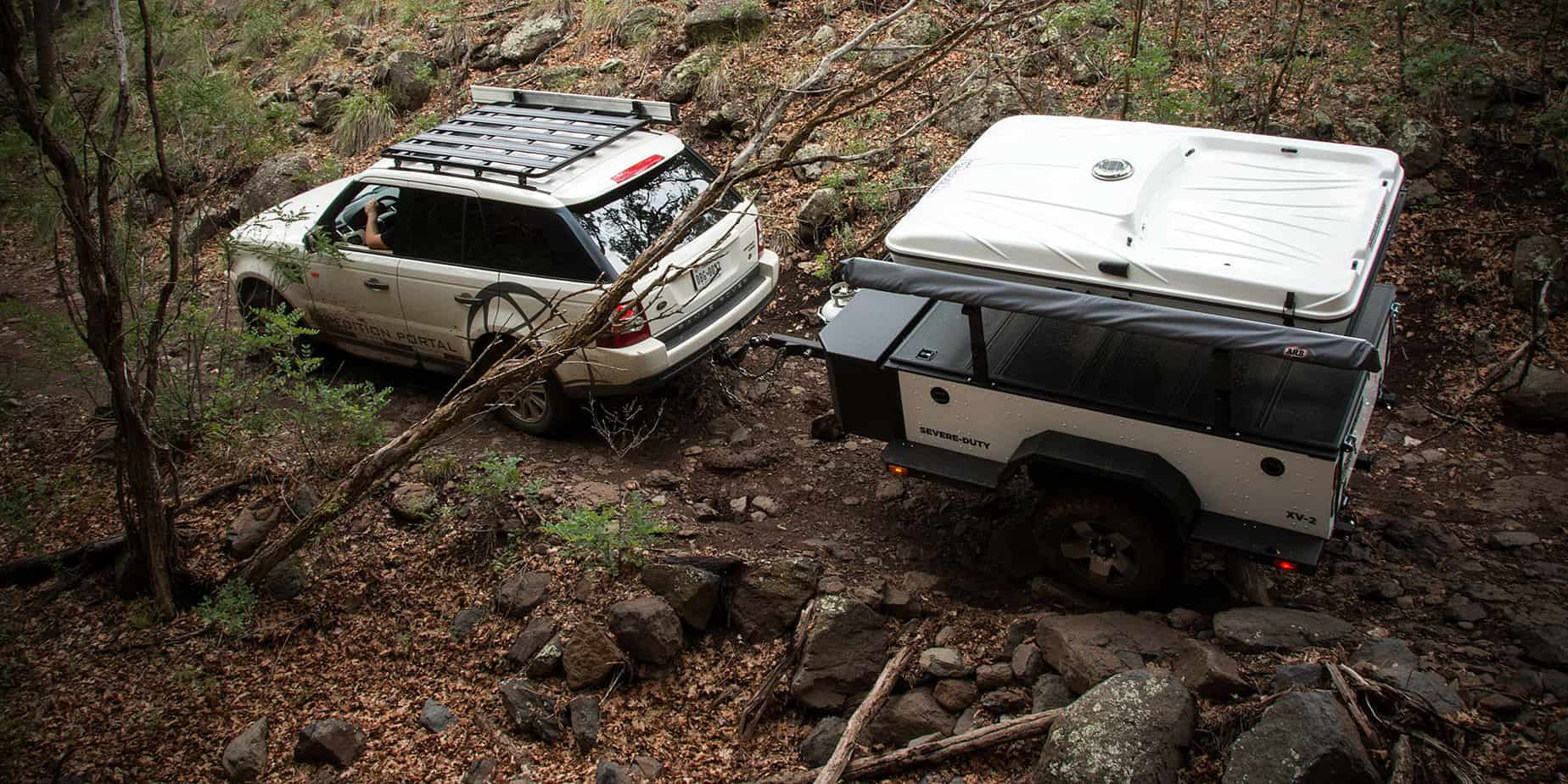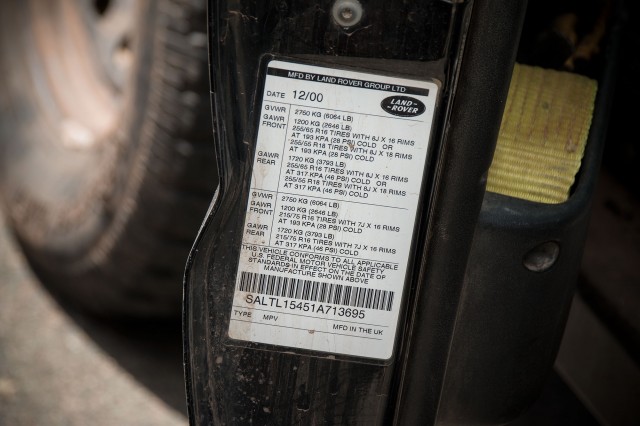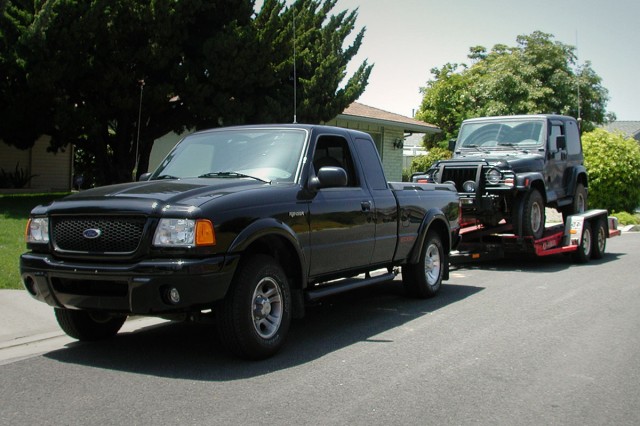When planning to tow a trailer there’s more to consider than just the rated towing capacity of the vehicle. Hitch rating, tongue weight rating, payload capacity, unbraked towing capacity (if a brake controller is not installed), aftermarket accessories, cargo, and passengers all affect the maximum trailer weight that a vehicle can safely tow. Adding to the confusion, manufacturers often exaggerate the tow ratings they give their vehicles in an effort to one-up the competition. Understanding how to calculate accurate values and how they’ll affect handling off-pavement is the key to knowing if your vehicle can safely tow that fancy off-road trailer you’ve always wanted. First, a few definitions to clarify the common acronyms:
- Curb Weight (or Dry Weight): the weight of the vehicle when empty
- Gross Vehicle Weight Rating (GVWR): the maximum safe loaded weight of a vehicle or trailer including all passengers, cargo, and accessories
- Gross Axle Weight Rating (GAWR): the maximum weight each axle is rated to carry, typically different for front and rear axles
- Towing Capacity (or Tow Rating): the theoretical maximum loaded weight of a trailer the vehicle can safely tow—payload capacity and tongue weight ratings are more often the limiting factor; ratings are usually provided for both braked and unbraked trailers
- Payload Capacity: the maximum weight of passengers, cargo, and accessories a vehicle can safely carry, including the tongue weight of a trailer
- Hitch Class: hitches are divided into general classes based on the weight they can handle; this rating is for the hitch hardware only, the vehicle may be rated lower or higher
- Gross Trailer Weight (GTW): the weight of a trailer when fully loaded
- Tongue Weight (TW): the amount of weight a trailer places on a vehicle’s hitch
- Gross Combined Weight Rating (GCWR): the maximum safe combined weight of a vehicle and trailer including all passengers, cargo, and accessories
Payload Capacity
The first thing you’ll need to determine before hitching up and hitting the road is how much weight your vehicle can safely carry on it’s own axles—also known as payload capacity. You’ll rarely encounter a clear rating in the capacities section of the vehicle owner’s manual, simply because there are so many variables that can affect it. However, all manufacturers will provide you with the vehicle’s dry weight (or curb weight) as delivered and gross vehicle weight rating (GVWR), which is all you need to determine the payload capacity of a vehicle. Typically these will be listed in the owner’s manual and on a decal affixed to the driver’s door. Note: pay careful attention to options or packages included with the vehicle, as these can change the curb weight. For example, a truck with four wheel drive will be heavier than the two wheel drive version, and will typically have a higher curb weight (and a lower payload capacity).
On a bone-stock vehicle the payload capacity could be determined by simply subtracting the listed curb weight from the GVWR. Since few of us have stock vehicles, there’s a little more math involved. In order to determine the actual payload capacity of the vehicle, you’ll need to also subtract the weight of any aftermarket accessories and modifications (bumpers, winch, tires, etc). Some accessories will increase your payload capacity, such as heavy duty suspensions or helper springs, just keep in mind that the axles and tires may not be rated for the extra weight (check the GAWR and tire load ratings to be sure). If an educated guestimate on weight makes you uncomfortable, public scales are also available which can give you a precise measurement of your vehicle’s weight for a small fee.
Trailer Weight
Now that you have the vehicle’s actual payload capacity you can get a better idea of how much gear and how heavy of a trailer it can safely handle. Everything placed in or on the vehicle will eat into that payload capacity, including camping gear, food, water, passengers, and the tongue weight of the trailer you’ll be towing.
It’s easy to figure out how heavy of a trailer your vehicle can handle based on the payload capacity your vehicle has left over: since the tongue weight should ideally be 10% of the trailer’s total weight just multiply by 10. Of course, if that number winds up being higher than your vehicle’s towing capacity or maximum tongue weight, the smallest number will be the limiting factor. For example, the remaining payload capacity on your truck may be 1,300 pounds, but if it has a maximum tongue weight of 700 pounds then the heaviest trailer it can safely tow is about 7,000 pounds (not 13,000). On the other hand, if that same truck is loaded heavily and has 400 pounds of payload capacity remaining it would only be able to safely tow a trailer weighing about 4,000 pounds. There are several weight distributing and sway control options which can help augment the tow vehicle’s capabilities on the highway, but most of these are counter-productive to the type of pavement-free roads we often travel.
Trailer Loading
The physics of trailer loading are surprisingly simple, yet trailer loading is often executed completely wrong. I’m not sure what it is about the off-road trailer industry, but we seem to love tongue weight. Water and gasoline (the two heaviest things typically placed on a trailer) are almost always found on the nose, and it’s not uncommon to see production trailers with 80% or more of their weight in front of the axle. This only results in higher than normal tongue weights and undue stress on the tow vehicle’s hitch, frame, suspension, and rear tires. It also causes unstable and dangerous handling while towing. The following photo is a perfect example: the gross trailer weight is well within the tow rating and payload capacity of the truck, but because of improper loading a dangerous amount of tongue weight is causing excessive sag on the tow vehicle and the front of the trailer. As a result, the tow vehicle’s front axle and the trailer’s rear axle are almost completely unloaded, which makes the truck difficult to steer while encouraging the trailer to sway and drift.
The ideal weight balance on a trailer is 60% forward of the axle and equally balanced side-to-side, with a tongue weight of 8-10% of the trailer’s total weight. It’s also important to keep the weight as low as possible. Balancing the trailer this way will help keep the tow vehicle and trailer riding level, ensuring smooth and predictable handling. Keep this in mind when shopping for a trailer or designing your own.
Trailer Brakes
An often-overlooked item, trailer brakes are essential to safe towing with trailers over the one-ton mark, and greatly improve comfort and safety when towing lightweight trailers as well. To quote an example from the Land Rover Discovery’s manual: the maximum gross trailer weight is 7,700 pounds, but the maximum unbraked trailer weight is a mere 1,650 pounds—a loaded off-road teardrop trailer can easily exceed this limit. Fortunately, trailer brakes are available on most of the adventure-oriented trailers offered today.
A common misconception is that a trailer’s brakes will function automatically when towed, with no additional equipment required. This was fairly common on older trailers, which used hydraulic surge brakes that were activated by the inertia of the tow vehicle slowing. Most modern trailers use electric brakes which require a properly installed brake controller on the tow vehicle. The majority of these brake controllers can be fine-tuned to towing conditions on the fly with the simple twist of a knob, and also feature a manual activation switch that can be used to apply the trailer brakes independent of the tow vehicle’s brakes. This can help keep the “train” rolling straight through emergency maneuvers on the highway and in the slippery off-pavement environments we frequently encounter.
The “X” Factor
It’s well known that travel off-pavement introduces a whole new set of considerations and stress on a vehicle. The same is true with trailers and towing equipment, and extra care must be taken once reaching the dirt. The tow vehicle’s handling will be the most obvious change as steering becomes more difficult, hills begin to take more effort to climb, and the rear end tends to slide around more easily on turns and stops. The easiest way to prepare for these effects is simple: cut the ratings and capacities in half. Now you know why most trailers designed for off-pavement use weigh between 1,000 and 2,500 pounds fully loaded.
Another difference to be cautious of is just how easily the trailer can get off camber on even basic obstacles. This happens because the trailer’s single axle has nothing to counter the suspension’s resistance, and provides little or no articulation compared to the dual axles on the tow vehicle. Thus, it’s important to keep the trailer’s weight well balanced and as low as possible, properly air down the trailer’s tires, and tackle each obstacle as slowly as necessary to ensure safety.







